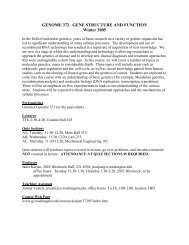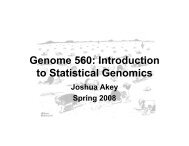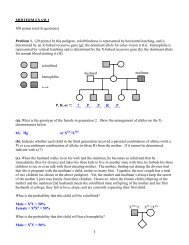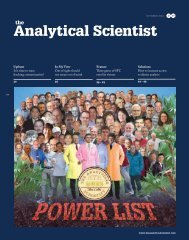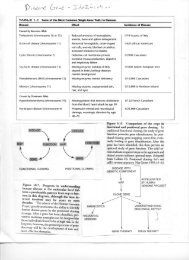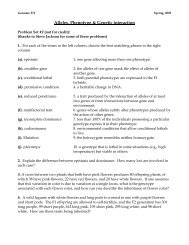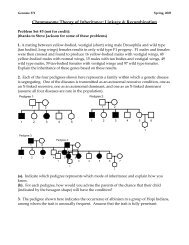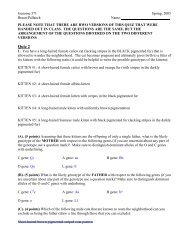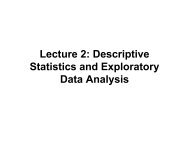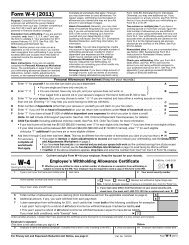Disease Gene Identification 1
Disease Gene Identification 1
Disease Gene Identification 1
Create successful ePaper yourself
Turn your PDF publications into a flip-book with our unique Google optimized e-Paper software.
TABLE q.rl<br />
SomcoftbMortCommonSFngkCmcTtabin~-<br />
Dhemse Effect IncMence of <strong>Disease</strong><br />
I<br />
Caused by Rec& An&<br />
Thalassenia (chromosome 16 or 11 )<br />
Sickle-cel disease (chromosome 1 1 )<br />
Cystic fibrosis (chr~rnosome 7)<br />
Tay-Sachs disease (chromosome 15)<br />
Phenylketonuria (PKQ (chromosome 12)<br />
Reduced amounts of hemogbbin;<br />
anemia, hne and splm enlargement<br />
Abnormal hemoglobin; sickle-shaped<br />
red cells, anemia, blocked circulation;<br />
increased mistance to malaria<br />
Defective cell membrane protein;<br />
excessive mucus produdion, digestive<br />
and respiratory failure<br />
Missing enzyme; buildup of fatty<br />
deporit in bmin; buildup des?roys<br />
mental dewtopmmt<br />
Missing enzyme; mental deficiency<br />
1/10 in park of Italy<br />
11625 African Americans<br />
112000 Caucasians<br />
113000 Eastern European Iews<br />
T /'I O,M)O Caucasians 4<br />
I<br />
Albinism [chromosome 11)<br />
Missing enrymg; unpigmented skin,<br />
hair, and e p<br />
1 /lO,MM in Northern Ireland<br />
I<br />
I<br />
I<br />
Catrsed by Dwnimnt A/&<br />
Hypercholesterofemia (chmos~rne 19)<br />
Huntington disease (chrwnosome 4)<br />
=-\<br />
GET<br />
A<br />
1<br />
I<br />
\<br />
% 'k.<br />
- - - Figwe 9.1 S. Camparison of tfie steps in - -<br />
FUNCTIONAL CLQNlNG<br />
functional and positional gene cloning. In<br />
mdicional functional cloning, the mdv of gene<br />
function precedes gene identification. In posi-<br />
(-<br />
tional cloning, Fne mapping comes first, even-<br />
--<br />
/'<br />
mally leading to gene idenutification. Gfter the<br />
WNCtlON TR~<br />
pcne h hen idcnrifid, dus then pmia an<br />
Le.-ttj<br />
A opoonal study of p e function. The solid arrows<br />
indicda required steps in the approach and<br />
dotted a m indimre optional steps. (Adapted<br />
t?om Collins FS. Pmitional clonin~ let's not<br />
call it reverse anpore. PJat <strong>Gene</strong>t 1992;1:3-6.)<br />
POSITIONAL CLONING<br />
Fi gum 10.7. Progress in undmmnding<br />
human disease at the mdedar level hllows<br />
a predictable pat-<br />
from top to kt-<br />
torn in this d iap, dthough the time interval<br />
inwlved may he years or wm<br />
demdes. ?'he advenr of the Human Genome<br />
Project prratly amlerates the abilig to identify<br />
human dirnv penes hy rhe paitional cloning<br />
smregy. After a gene has been identified, preventive<br />
medicine smtegies can h designed for<br />
chose individuals found to be at hgh risk. h the<br />
long mn, however, the greatest prumir of ~ n e<br />
dimvery wilI be the development of new and<br />
more effectjve therapies.<br />
I - --<br />
M*ming protein that remows choleslerol<br />
frwn theblood; heattattack by age50<br />
Pmgressiw mental and ~eurolqical<br />
damage; neurakogic disardm by ages<br />
4670<br />
-. . - . +<br />
- --<br />
DISEASE WITH<br />
GENETIC COMPONENT<br />
I<br />
1 1<br />
MAP<br />
CLONE GENE<br />
A CCELEFIR TED<br />
BY HUMAN<br />
GENOME PROJECT<br />
DIAGNOSTICS<br />
/ BIOLOGICAL DEFECT<br />
J<br />
PREVENTIVE<br />
MEDICINE<br />
---<br />
GENE THERAPY<br />
f 1122 F mh Canadians<br />
1 J25.000 Caucasians<br />
-- -<br />
DRUG THERAPY
,-<br />
1. Black urlns dl-<br />
-<br />
2. Mendallan mcwmb<br />
A KU<br />
. I<br />
j : Cases of hy%Mlzatlon -<br />
. .* m.<br />
I .'<br />
\<br />
9. Proposed enzyme deflelency<br />
Homogentiskc acid<br />
1 EnMHGO --<br />
Maleylacwtmcetic add<br />
8. eONA finds gsns h~ k gmmlc Ilbmry,<br />
4. AKU gene mapped<br />
I- I- Till 1 1 1. I rl-<br />
I- "I.<br />
9 P<br />
C h m<br />
3 ('-'ILz<br />
3s2<br />
AKU<br />
C<br />
I<br />
I<br />
-I l. re .--<br />
Y<br />
HGO gene (1 4 exons, 13 Intrm)<br />
-<br />
5. HGO Idatsd Crom fmgw A~pemIih~ 10 *-Primer 12 --<br />
I<br />
9. PCR a! mena 1.0 and 12 find mutsfit sltm.<br />
- .:.: -<br />
, HGO<br />
-<br />
. '?<br />
--t<br />
m<br />
- -bz~300G ---<br />
- - ---7 m s<br />
4-<br />
HGO gene<br />
-<br />
8. A-Ius HQO finds h um cDblA. 10. Inmncs oi muteHons<br />
Figure 11-22 The steps in unraveling the biochemical, p Mc, and mnlecalar basis of alkaptonuria.
Empress<br />
Victoria<br />
Albert<br />
1<br />
Victoria (1 81 9---79Dl)<br />
Kaiser George Princess Frederick (Alexandra)<br />
Wllhelm lI V Irene Alix Tsarina<br />
Nikolas II<br />
Alice<br />
of dthlone<br />
Vjctoria Leopold Ma1 mrr<br />
Eugenie<br />
(wife of Alfonso XHI)<br />
FIGURE 15-72 A partial pedigree of hemophilia in the British royal family descended from Queen viaoria. The pedigree is<br />
typical of the transmission of X-linked recessive traits. Circles with a dot in them indicate presumed female carriers heteroryga~;<br />
for the trait. The photograph shows Queen Victoria (seated at the table, center) and some of her immediate family.<br />
Iim<br />
Figure 9.4, Psdiffse 3-g<br />
of<br />
the p e fw -0nic-b to the serrttm<br />
laus. 1-d~- with rdrd~h&<br />
arc a f f d with xurmrd dominant myntonic<br />
dysaophy. In A are shown rht mtm<br />
phenmypcs (+ or -) for tach of the inclividu-<br />
PIS IR the pli- Gcnotyp ore infmcd in<br />
R wing the fact that rk Sr allclc b d b t ,<br />
so hat + individuals are either S& or SeJq<br />
and - individuals murr he dsc. Tbc po-<br />
typesofall ofthe + indivictuabuqx form-<br />
- mu bc infcd hy the ncrmity of<br />
Mendelian inhctinm* at the sccretor locrrs.<br />
Thus. for mrnplc. individual 1-1 must k<br />
Sdw, nw %, 1-usc he h three seJw<br />
06qn-h~. I+M of B show rhat the myntonic<br />
dystrophy p e and the Se dele at the<br />
sccrttor locus am appmmdy linked in this<br />
pedim.<br />
- -.
(a) Key = 0 Norma! lemab<br />
O CRMW ( twtemw~) [wrmla<br />
0 Normal male<br />
AHectod male<br />
I<br />
Albert<br />
ck-@<br />
Warla<br />
(1819-1901)<br />
1<br />
Innclivr! IX - Active lX<br />
I<br />
Fnclors<br />
XI1<br />
XI<br />
IX<br />
Vlll<br />
X<br />
v<br />
Prothrombin<br />
Fibrinogen<br />
Wlld-Qpe<br />
person<br />
Hemophllfat<br />
t 4<br />
+ +<br />
+ +<br />
+ - -<br />
+ +<br />
+ +<br />
t +<br />
+ +<br />
Fibrinogen - Fibrin<br />
(d) Purlfled<br />
Faclor Vlll<br />
I<br />
Obtain arnCnb<br />
acid sequence<br />
I<br />
Reverse translation<br />
into coding sequoncs<br />
1<br />
Synthoslxe degenerate<br />
oli~nucloot~dos<br />
I<br />
Probe llbrary<br />
-<br />
I<br />
Flnd Factor Vlll clone<br />
1<br />
Structure of gene<br />
AG lTG GCC TAT CGG, ,,<br />
.,..,..,...... ..,...., ,.,..<br />
1<br />
....--.<br />
TrhuCcQaaTm<br />
TITMCCWATAOCC ...-.<br />
TltiMCp( iGATAOCC<br />
-<br />
as datmilwld fmm 11- I -L- 1-1- 1.- _L--I ...-<br />
CIIXIP m o 20 no FO nn IM I'Z~ 1.10 ~tn ~ B O m - - --<br />
Agum11.16 How~~~drknsdtha~uI.A~.(rr)Aprdlgmdthcrqrslfaml~desctndcdtnwn<br />
Vllccll Wctona. 'This tarrltly trw uses !tic rl,sndard (nrdrqrw rymbols. (b) fhc- bkal-clotthq cbxade. Wwl dmaqe indum a amde 01<br />
m~rymatic emts Itrat ronvrrt inactiw- lac ton lo active l~tcm. 71rc c,rxaclr r~wlls In thc trilnslnrmaliun of hbrinogen to tlhrin and Ihe lonnathm<br />
of a clot. (c) Rid tsls can detcrrnlne whether arr active lonn of each f,ictor cnvokd m the clolt~q cascade is prcsenl. Thc rmult. of such<br />
analws show that many hcmophil~~m, such as thme lwmd in Qwm Victoria'c ped~qrcc, lack an ac!we Factor Wll In Iheir blood. (d) Research<br />
purllied Factor VIII, detrrrnined ~ ts amiwcid sequence, u d thlr ininmation to infer all pxsible dqwmatc coding qomccr. constmad<br />
oliqol~uclcollder tor a rcq~on wllh rn~nimal degeneracy, probed a q m i c library with Ih~5c oltgonuclrnbcks. and obhincd gmrnlc clonr.~ d<br />
thr radar VIU qm. llwy qu&<br />
Mt- clomr to dclrrmtrw rhp qenc's arlual cdiq wquwe.
Fkpm 7.29 Honr mutathms modukta Ilght md eolar<br />
pnrapth. (a) Arnincwcid substllulrons (bkk&Is)<br />
that dlmrupt<br />
rlmdqnin's Ihree-dimenwowl structure result in retinitis<br />
pgmrmtourm. 0th whrtihs diilnnh~ hdopdn's clcmltw<br />
-<br />
to lyht cauw nlght Mlndness.<br />
----<br />
MurATlON<br />
SEARCH<br />
. NORMA!.<br />
M<br />
faENTlFICAlION<br />
I TFIANSCRIIT ffim<br />
ci Kt"<br />
YACa AND<br />
mcs<br />
Figure 9.31. Schern~tic of &c gencrsl appmach to paaltionml cloning Thntlph a<br />
un~r(necywgcntric rhnormnlity ~caqionnlly pruvidcsn ahoncut, the di-se getir isuruallv In#.<br />
ri3IIy mapped hy l~nkapc analysis oiaffectccl I;imilie~ using a laqy hmry ofpcrlporph~c I)S \<br />
marken (a pcru)rnc scan). Snriietimcr n likely candidate gene i5 qitickly idcntitied hased on 11s<br />
function and known Incutinn r~car where rlic ini~ial ditmc Rcne has bccn mapped (lowrram;~).<br />
7 h~r sl~orrcut is ohrn rclemd to ar rhr pori~ional mndldatc appmach.
" --- . - .- '-J-u<br />
--nnq-mtamqmi<br />
W 4 em -1- *pwJu!+al<br />
d~ pur Llolr pw Rnybr palepuwtun<br />
S Pm .5 4 1 m-1 Ypralwokn. pur uwoq<br />
kfi prr lado .u*lrplkr WBq qllm ympHIpn<br />
--<br />
u'PIlolParlv*uluadRO#PWIUSN4odur,mkn<br />
-w 9 .C PW r 'I ~mxa IU~PKI+~I IQSN Mtx,<br />
-09 -6 pr* -6 ~?mtpul wry filit~q<br />
m b m WJW* =)a+<br />
(sp+rur<br />
HH4 k payo)W amqrplq .Fan tuuwd3 &%I.'<br />
ga-q -n mlranlarl mm PIP PW ~undrpaq<br />
sf% fiunmclr dm P~~LKOJ,-JW~~ 'e .ewW<br />
.LgpSWYmRWt ul wcvlmnlu barn L .61 j<br />
**'
-. -A-<br />
Normal<br />
H O m O r y tw ~ 1.5-Mb<br />
duplicetlon-smem3 dl-<br />
*<br />
-<br />
Activating point mutntinn<br />
,<br />
:zz+<br />
,=~<br />
duplicated mglon<br />
Figure 16.k <strong>Gene</strong> dosass sffsch with the PMPZpens.<br />
- -- -- - -<br />
- - L<br />
MOS! pationrs with charcm-M~rle-Tooth disease are heterozygous for a 1.5-Mb doplicdon at 17pl1.2. including the gens for periphersl<br />
myolin prateln, PMPZZ(colomd box). k pallent ~ O ~ O ~ ~ Qfor Oihe U S dupl~cation had vary severe d~sesse. Some pdents have only two<br />
-- - ---<br />
copies ot tho PMPngene, but one copy cvrrles an acl~vatlnq rnlrtat/on.<br />
n#rdrWOrSchnakRP.*rr*.lhndrn<br />
Lnvl nntrR~ nt wmparath w mk wldm<br />
~GtnnflWAngnlmtnRACMYA~~ravmrb<br />
rcrr~hu~n~rnn~tm~pabrcmmrm.<br />
hnvm bnn nrtnrwpl In tNmm fmn rhor mq~w<br />
rrirlnq the rmmlnnl M ot t h pslm (prm) to u rn<br />
rrprmrnrlm t b trrmlml rrrd of the q nrrn (qtrr).<br />
Th.tmrOlDNAh~.*lhs(lnrm+r*lIhe<br />
taH DNA h LnhrM wRh mY dyr. C ~ml WklfMbn<br />
lhsvrl wlfl prrmrtrnn ydknucokr. Frm orrnmrrrinl<br />
In lhr. ?r* DN4 wHlnwn Inn r d Jqnol. ml<br />
*'I IPwy of wnomlf mmwilrlnl Mll pr- n ~pmn<br />
In tfm CGM +M, Um mard DNB h Imm<br />
b frfmh?. 7M p%wm.autonmnl rwlhm In X-n ma<br />
Ip+m nm wmlca wllh!*m~~rl~mtlmh.
(a) Pceparr: mlcmerrey.<br />
Human chromcwome<br />
(b) Prspate genomlc DNA mmples.<br />
Conlral ONA<br />
test DNA<br />
I hbId\h<br />
lhrorescenl dye<br />
-- I<br />
f-9<br />
......................................<br />
......................................<br />
MTw logelher nnd denelure<br />
......................................<br />
I<br />
......................................<br />
(c) Incubate mlCrm~<br />
...................................... - , <br />
-----..<br />
_.-Y<br />
- -<br />
Wlth cambtned esmplas.<br />
' I . , .<br />
6 I<br />
-\ /'<br />
Human chromosome<br />
K* pin? db<br />
- i \<br />
~ p (3.35 . Camprnttvt MnJI M(au duplhtkons, del~s,<br />
and neqJoI@. (a) MC d m npmrntinq<br />
tl~t~~tnan<br />
cmtd qmm* sarnpk i~ labd with a mnd cdar dye (y~lbv).{c) The twn mmph n mixed tqlhrr, dmaturwl, a d ihm incubat4 on<br />
~h mrrmmy. (at) A~nanatd annbis of each spot m the rnW.ly &t&s the h~ta nt Vlc two dywf pDb" !hat hyb.dke. Qmqs YUIIcates a<br />
1.1 ratio; athn rdm indl~ba d~Wbri {0.5:1 ralio; p4k1~) a dup6caIicn~ (131 ralio; &) of WC chw u(urtun in th, test sampb.<br />
genrmr arc yatld in o ds on(o a micmanay. (b) Thc qnamir s.nnp!e lo b tend k labelol wlh ar cob dye (me, m, and thc<br />
-
dsfactiva Onne<br />
caunlng d~sse*a\<br />
11<br />
SNP marknr on<br />
thlr copy el<br />
chrorno$oms only<br />
chromosom~ pnlr In<br />
mothar with rllsa~se<br />
I<br />
TCSTS PI<br />
I<br />
-ma chramosom~ pafr<br />
in disoa5a-frao f~lhor<br />
I<br />
worm<br />
: 1 ' I nann causing dlaoaso 1s colnhnrltod with SNP markorlrom dlseawd mother In<br />
76% of tho dlsenaAd progeny. If thle same carrelstlon In ohserved in olher hmllias that have ban<br />
@xarn[ned, ll~n gnnn cnuriln~ dlscase la mopped to lhls chromoaoma close to Ihe SNP. Note tho1 a SNP<br />
(hnt La either fmr sway from tho Ortno on the mma chromorcomo, or lmled on fl dlfTarnnt chromolomo<br />
rl~nn rho pno of ~ntoresl, will br: cn~nhorlted only 50% of ihn time. -<br />
--<br />
-<br />
1<br />
Figure 8-59 Csnetlc linkage anah<br />
using physical markers on the D N ~<br />
to find a human gpne. In &Is PY.~~~,,,,<br />
one s ~dit~ the colnherltlnce of a spec#<br />
IC<br />
human phenotype (here a genetic dlqp1,q<br />
with a SNP marker. I( Indivldualr wr,o<br />
lnharlt the drsexre nearly always inhwr<br />
particular SNP marker, then the gen*<br />
causlng the dlseass and the SNP are llko+<br />
to be close together on the chmrno~%,<br />
as shown here.To prow that an ohw<br />
Ilnkage Is rcatlsllcally 11plflGinc. hundmd,<br />
of Indlvlduals may need to be axamlngd.<br />
Nore that the llnkge will not be abtolu<br />
unless rha SNP marker k located In [he<br />
gene bslf.Thus, occasionally rhe SNP<br />
ba separated from the disease gene by<br />
melotic cmsslng-ova7 durlng the<br />
formatlon of the egg or sperm: thlr ha *<br />
happenad In the casa of the chmplr<br />
on the far rlgh~whtn w~rkly wEth a<br />
sequenced genome, thls pmsdurp wuld<br />
bc repeared with SNPr located on either<br />
sjde of the Inlrhl SNf! until a I m<br />
colnhedtance b found.
Rgwm 1.20 Cystk flMs: A mcedve condltlw. (a) and<br />
(b) ~llurtratr the pvdlqter.r ot famiti- with tyllc fibrordr. In [a) a<br />
cnnssmplneous njat19 In qencration V hrwcen unaffected third<br />
cdm (V-1 and V-7) who an! cmncn (hFt~.rorygoter fm the dominant<br />
nomral ale CT* and thc rccmrivc dka* all~h. CT) prcducm an<br />
aff wlrd Ct CF daughter (Vld). Simihify, VI-1 and Vf-2 are canien and<br />
Ihr~rt CFCFhomcrqqaus dauqhtcr MI-1) hm llw diwaw. I1 Is probablr<br />
tlk~t irrliuzlh 11-2, 11-3, 111-2, Itl-4, N-2, and N4 arc all canim or the<br />
=me CF alMr inhetitd fmm 3 common ancestor in thb Ivmt<br />
gmemlion. W tannot detmiw which of these Ioundrrs (1-1 or 1-2)<br />
was a can&, sa HIP must d p j i ~ their t ~ CpWlyp~ as CF'-, kauw<br />
Ihc CF akbe Is r&lMy ran- In thir population, 11 IF like that mart<br />
unaffeed h&idwls unrclatd by bld<br />
(11-1,114,111-1,111-3, IV-I,<br />
and TV-3) am CT ' CF' hom?yqotrn. Ihc q~notyp~ of the vrnaining<br />
unatfedd people (Vl-3, Vl-5, md VII-2) is uncertain (CF '-1. (b) Two<br />
familm in which car& parenu pmduce multiple childwn with cystic<br />
fibros~x dernrmrmtc hon;ront;ll pallcmr of inhrrilame. W~thoul furth~r<br />
inflmnation, thp unaffPctPd chDdm in each pdiqr~e must be<br />
rrq.mkrlashminqaCF'-vtp.<br />
n w<br />
A HOW molawlsr rnatWns helped locale the wane far cWlC<br />
flbrnl5 (CV.
-? U u<br />
I 80 kb :a; 5<br />
-<br />
c' " m,<br />
-, -8<br />
r. e-*-,-, EukRry6llc DNA ,. - 5 > L .<br />
-.<br />
I/ Cul with EmRI; lnserl belwccn ).arms<br />
-------<br />
b<br />
Lu-d<br />
""'"" /<br />
Scmn with<br />
u<br />
gone probe A<br />
L -=-.-<br />
--<br />
:.,.,I- . .. ;<br />
J.)<br />
Subclone small fmgnent<br />
' : Ramen Ifbrary<br />
i/<br />
,.- L!i 7 , .':<br />
Adlacen1 clone 2<br />
I!<br />
Subclone amall fragment. ete.<br />
ln 4 . "<br />
-r -..- - I;?<br />
a .2 n?<br />
----m I -I-., a- r~n' K!.<br />
- -"-*-.-AL. - -.- .- 2 2.: + 1<br />
. - -2G ,-h-A* ;r'z<br />
- #<br />
DNA Fragment<br />
-7, J<br />
- 1<br />
I<br />
Slartlng polnt<br />
0<br />
Cut<br />
Cut<br />
r /<br />
1 1<br />
1<br />
.-.- - . .-<br />
Bldreeflonal walks<br />
L- ----- A- .-. I ?<br />
Use as scmd Jump<br />
starling point.<br />
figure 74-79<br />
Manipulsfimg cloned ~ennrnie frapmcnlx for<br />
chromrwnmc jtrmpin~. a mbdiftcd lype or chmmrnnmc wnlkinp that<br />
can hyplrs rtpionu difficllll tci clone. sctch nn those conlaininp.<br />
lc~lilivc DNA (see tcxt).<br />
-
Clm Into EcoRl cut plasrnld<br />
Trannlorm bacfnris<br />
Select for fi
(a)<br />
Chmosome 7 267cM<br />
' barid<br />
I<br />
" t<br />
4 candidate genes I CFTR<br />
(C) (4 - Clone<br />
showlnn<br />
m hybrldlzslion to CFgcno ,<br />
kb0 SO 100 150 200 250 300 350 400 450 5Jh3<br />
". , -<br />
-,.I-<br />
.-'7- .-. . s CFgene "<br />
.c<br />
Le)<br />
Exons<br />
~i 14b<br />
1 23 4 S C Q 7 8 0 401112 13 \ / 15 161Tal7btl lBZa21ZL~ 24.. I<br />
.................-.-. ... . . ........ -<br />
.I.............<br />
m.7<br />
. . a,....<br />
.. ..<br />
sm..<br />
.I (I0 ..D<br />
I..<br />
....- ............... ,<br />
.. ". ".<br />
111 11 1 1 Ill111 1 1 1 Ill II IIII!.-;<br />
Mutations<br />
F<br />
285- Corresponding wilcllype ~olded pro!n:n<br />
polypepHdo structure<br />
Insefled Into<br />
membrane<br />
m Y.<br />
75 4.zL<br />
Flgura 10.19 Posftlonnl clanlng of the cystlc flbmslr gene: A Mew. (a) Linkage analyrir places the Cf locus on chromosome 7. Th<br />
idlogram of chmrnoson~r 7 show< lhe positions of markers-met, XV-2c, KM.19, and J3.11-that del~ne the I- to 2-eM region within which 1<br />
IOCUS must lit. (b) Wcllklng from a liriked marker to the CFgene. Us~ng the closest linked marker (XV-2c) lo pmbe a cosmld llbraryof tkgMOl<br />
(with avcrage insert sizes of 30 kb), re~earchcrq putled out clones that they characterized. Thy then used the ends d these clones to probe Ih<br />
library again. Thcy rcpcatd thb pnxcls many tim~r to obtain n contig of 2RO kb. Withln thir 280-kb region, heyi id en tilled four tnnscription<br />
units. These marchers punued thc cloning of thp Cf gene before the development of the YAC vecton that make it pos.rible to prducc law<br />
ln~crt genomlc libraricc. Tday It would be easy lo obtain this entire contig on a single YAC clone. (c) Northern blot analysis reveal5 that only c<br />
the andidatc genes is expressed In Ihe Iungr and pancreas, both affected tissues In CF individuals. Thls candidate (now known as CiTR) is not<br />
~xp~~~scd in thrn brain, liv~r, or testes, all Ussues that are not aHccted in discad individua!~. (d) The 5'end of the CFTR gene was located a[ 01<br />
end of the original 280-kh contig and found to extend ovsr 350 kb of DNA. (e) €wry Cf patienl has a mutated allrle of the CFTR gene on<br />
her or his chmmosom~ 7 homolqs. Tht. locations and types of mutations uncawrect in d,ifrr~nt patirnrs are shown und~r the diagram of the<br />
qcnc. The normal gene encod~r the wild-type protein.
Normal<br />
[DNA ..,OM AAT ATC ATC TIT M T OPI TCC...I<br />
Protein Glu Asn lle Ilo Phr Gty Val 9f<br />
Posl!ion 504 505 508 507 509 509 510 511<br />
-9.17 Dlrwt-dUnmnost-qek<br />
fflrrwl~mhThr C F ~ ~ ~ t ~ a ~ ~ 2 5 0 , 0 0 0 h m e ~<br />
and Is qan17Fd In 27 Pxons. It encode\ a prolein wilh 14AO amino<br />
a~irJr. (a) Thp nlost c m m dtwase-camlrq mulalion in Che C% cjm<br />
nackhkmolIhmehine~on 10.ItaporsibktoamplilythE<br />
rt-qlon containinq the ril~<br />
of the most common mutation by K R d<br />
r'lvldr the PCR prducls into twu alquols. You thm blot the al~qudlr<br />
expressing 7 7<br />
onlo fiftpr papm and pub with AOI lm th~ mld-type and muwnt<br />
RNA paharase<br />
nll~kr, Thr AS0 f a thr mrtant all& Cmtm by the of I t m<br />
barn fmm tho AS0 f r thc wild-lyp allele.<br />
T7 RNA pab:m.e nlrno<br />
I<br />
PrCURE 12-11<br />
Expression of the cyjtic fihrnzir gene (CF) in a vaccinia<br />
vin~s vector. To provc thnt n wild-tvpc CFgnc could<br />
correct the ion-rranspon rlcfrct in cells froni a cysdc fibrosis<br />
psricnt, rhc wild-rypc gene urns expressed in rhcsc cells<br />
using a rwo-campancn~ vaccinia virus cxprcgion system.<br />
Firsr, the rclls wcrc infectctl with n specially cnginccmd<br />
vsccinia vinls rhsr carries rhc gcnc cncocling bncrcriophagc<br />
T7 RNA polymcrnsc. l'hc infibctcd cells I~cgan to producc<br />
the RNA plymcrasc. Ncxc, the cclls wcrc rrnnsfcctcrl with<br />
a plnsmid carry in^ the wild-vpc CI: gcnc dnwnstrcam of s<br />
becteriophagc 'l'7 promoter. The 1'7 RNh polgmcrasc<br />
cllicionrly transcrihecl the CF gcne into rnRNA, nntL the<br />
mRNA nns rr~nsli\tcd into protein. 'l'lle resulrinp: cells were<br />
nnalyscd for rhcir ion-rmnspon acrivity and found lo hivc<br />
normal activity, proving that the clnncd CF ~crlc could<br />
correct thc dcfccr in rhc parienr's cells.<br />
Imndwt D M<br />
info cells using<br />
lipofw6ction<br />
Harvest cells ,-<br />
\ CF mRNA<br />
CF protein<br />
Anolp srpression<br />
of CFpdein by gel<br />
clecfrophorcris<br />
Assay<br />
imchmnel<br />
activcty
Original markers - M3<br />
lo oblarn rough<br />
postton<br />
I<br />
Exten! of map position ol<br />
diwnse locus fwnd lo<br />
linked lo M 1 nnd M2<br />
with each marker<br />
(b) H-m-H31-l-421-K1 / ltvacdosast<br />
mnrkors thnl<br />
NW markers used hf higher- hllneate di5-w<br />
resolulion linkaqe analys~s locus<br />
M4<br />
Campare andidale<br />
from NO ~ ~ U J01 I S people<br />
--+- Normal indivkiuals<br />
with phttn(rm<br />
lndivWual9 with<br />
mntanl phwtype<br />
Rgum11.17 Pt~ftkmdclonlnq:Fran-to<br />
chmmosamal Iaatlum to gulw gam. (A) C)maqmrn d a human<br />
chrc~rnornmc wrlh four rna~kcrh -MI, M2, M7, emf MLud<br />
In !he<br />
11nk.iqe analytls of a dtwarc phcnoiypc. Each markcr prwid~r 7inkaqe<br />
covrraqr" of a portion of thr chmlr~osome. Tlic ~ ~ of COVCT~JP q b lor<br />
each marker IS thp wgmn wlthln which lrnkagc to a disease k l r cwM<br />
be uncwcred. In thc t~ypblbltcal study ~!Imlml~d hew, Itnkaqc. has<br />
hen drtcctd lo adjacent markers Ml and M2. This ruqqesu that ItK<br />
gcnc rmponr~ble lor Ihp disease 111-5 between Ihow mark[-rs. (b) Will)<br />
Lhts ~nfatmnlion, an Iwt~gator rwld typ addiiisnal mnrkem that IIC<br />
between MI and M7 to psrlron Ihc diwav locus wll\ Iliqh~r<br />
rrzolulicm. (c) Looking for candldatc pm. Anabir of Iljc nqim<br />
betwffn rccomhirwt~on siter !hat drfine the smallrxl drca wlthrn<br />
whrrh tlic drwitse Iocus can lit- rtrwld rcvral the prPscnce ol randklat~<br />
gPne.r. (d) Flndrng Ihc c m t cand~dalc through comparisons of Lhp<br />
Tlnlcturc and cxpr~sslon of rach canrlldate qenr in many dircarrd and<br />
nondiscased indlvrduals. A corrclalmn between a mutant rlructun or<br />
exprerrion lor J piirtlcular ciindlhtc gene and the diwau ph~nntype<br />
can pmdc evidPnca that a lpnrtrcular gene is mpnnsiblr fnr ttw<br />
dlreaw phenolypc..<br />
-<br />
I 7<br />
TABLE 1 1.2 Complexities That Alter Traditlonnl Nkndensn Ratles<br />
Prohlern In Obre~ed Relatlonzhlp<br />
Category of Complexity Between Genotype and Phenotype Changes Necessitated In Mapplng Strategy<br />
r,<br />
Incomptrltc penetr,incc<br />
Rhenocopy<br />
Gmrtic hetemqmeily<br />
Polyrl~wic determination<br />
Di5Pl~r genotypc can wrilr in dlr<br />
individual who does not expm the<br />
daease phmotype<br />
<strong>Disease</strong> phenotype can b expressd by<br />
an indgdual who dws not hrwe the<br />
disease gcnotypr<br />
In diff~wnt famllim, diffmnt disease<br />
genotypeq are mponuble for the wme<br />
diwase phcnatype<br />
Mutant allelm at mow than onr locus<br />
influence exprenion of Ihe disease<br />
phenotype n a singk ind~vidual<br />
Ellminatc nondircared individuals from analpis<br />
-<br />
Proqram computer to flag unexpected carps of<br />
ruppowd double r~comhinatlon wen& that flank<br />
a pitalive diwarp locus<br />
-<br />
Divide complete set of dis~ase-tranrmittinq<br />
famllies into subgroups ( h s 4 on various<br />
parameterr such as nveraqe age of onset) and<br />
perlorm linkaqr analysis separ.rtrly on each<br />
subgroup<br />
-<br />
Prqnm cornpuler to search for complrx<br />
palt~rns of arsmladon ktwepn the d~rmw trail<br />
and mulllplr loci<br />
J
J7J (73 DeceflsM<br />
13rcasl cancer<br />
@ ovarian camr and doceasad<br />
Q) Other cancer and doceasnd<br />
Ftgum 11.23 Cem?lk httemgcntlty: 1IYMstbru M dWcrmt Id<br />
cam gtvt CCK to t.k same disease phenotype. Roth pedi- in<br />
lh~t liq~m rhw wldpnce of !he tr.ln%mrssron of a domlnant mutatlon mth incm~plcte pmctrance that raum t>rp4r\l rdricrlr. LinL1,rrpl analylir<br />
shtnvc Illat Ihr mutil!iOn In the lint ped~qrw mrdrr on chmmorornc 17, whcrrar thr mutation in t k second p~d~qrcc it en chronio~urnr~ 13. The<br />
fint family ir qmling a mulanl BRCAI all&, wh~l~ the %wand farnib is sqwqatlnq a mutant RRCAZ n1k.k..<br />
Lewnd<br />
Male 0 Female<br />
a ZI~kcd<br />
0 Brensl cancer<br />
I:) Ovarian canmr<br />
(1 B~lolnnl broost cancer<br />
~gu&0,14 Llnkqe mrpplng of the b t uncar gene<br />
BRC.41. (a) Podan ot a !my prdqrce showirq Iritnrmrrion ol the<br />
hw,i\t cancer phtyp~. (h) Obla~ninq incr~a5inqty qreatrr rpxnlut;on<br />
in mappilrq Ihp RRCAI ku5. Rwarckn lint rnapp~rl l BRCAI ~ lwur<br />
In 11nk.q~ wilh smal markers (Dl 75750 etc.) .v~ild w~rt along 1b<br />
lotq drrn of lu~nwri rhronwmm 17. Following dwnonstnl~rm d<br />
IinLcy to Ihit rqon, th~y ranid out hqhcr rmlution mapping 4th<br />
(b) Chmrnasome 17<br />
3 markro and gpnrs looted btwcren Ihc two oriqlnal n~arkcn<br />
m<br />
Marker Cnndiats<br />
74 t 1<br />
Dl 75250 and 01 75579, which defi~w Ihe extent of the reqion within<br />
Flcmffj<br />
which BRCA l had to lii.<br />
21 3!<br />
PI. 1<br />
31 1<br />
13 ' ' !‘-:<br />
-
FAI,RII<br />
Candidate genes<br />
IEII DC:~ i DCI e ~ci.1~1 AIPCICH.<br />
- ---- - -<br />
OlfS5as P<br />
r 1 1<br />
PW DWT,7'il UTl04UTV3 17-HIiO Dl 7W4R U fa W U13BS MS<br />
6 I I 1 I Ir-'I 7-7-<br />
W3ZU DnmM K ? m WRA I*rRA I fw<br />
Dl7SST9 CPn1 DI7SlA1 PPY UT61 RNG? D17SB55 CI~lR' DITS?76 A m UTE? Dl-6 lJWll7S ZSkm.lkr Dl?%11~7 I)lW CSf3 U1;10'.<br />
1- t- 1- L~rnlts of location lor BRCA 1 4 --I 4 --I<br />
1)<br />
kpm 16.15 Physical MuqqAng of the BRCII Loas. Wlh many family pdigrccs and mark- in Ihe RRCjll reqbn, mearchen locallzed<br />
thi7 BRCAI 1mus klwcm Ilkrbly rmomhindllon vies that delineatd a mion lcs~ than 1 Mb In Imglh. Aftrr cloning ih entire mian into a w w<br />
01 owrlapping YAC dnd h~lt*~i~)pI~ilg~<br />
CIOIIPI (41 YACS and 11 phaqes), they idmtiiwd ~IW candidar~ gmes tht seemed to be cotransmitt~d with<br />
Ihr RRCA 1 mutat ion.<br />
- - - -<br />
+ All complex mltr<br />
$<br />
/<br />
d<br />
i<br />
90<br />
80<br />
70<br />
ria<br />
flg. 1, ldcntlflcatlon of genes underlying human Mendellan traits and genetically complex tralts ir<br />
humans and other species. Cumulative data for human Mendelian trait genes (to 2001) include el<br />
major genes causing a Mendelian disorder in which causal variants have been id~ntlflcd (58. 59)<br />
This reflects mutst~ons in a total of 1336 genes. Complex trait genes were identllipd by tht<br />
wholegenome screen approach and denot~ cumulative year-on-year data descrihd In this rpvlt-w
-<br />
New mulation (M) In (b) Three reglons (c) Collect DNA samples<br />
encestral population<br />
ol haplotypes from rare lndivldunlr: wHh<br />
dlsease and a control group<br />
* I B l C conlainlng an equal nurnbr<br />
without d1Seas0<br />
1<br />
<strong>Disease</strong> group<br />
-<br />
I Compare fmquency of each ]<br />
I&<br />
haplotype lrom each ragion<br />
40 genecarlons batman tho disease group<br />
the control group: The<br />
only slgniflcant dlftcronco Is<br />
M !<br />
e....,... I .- In the blue haplatym ol I<br />
uulllrul MIUUC,<br />
I I and<br />
region 0. which oihiblts a<br />
much hlgher lrequency in<br />
fhts dlsonse group.<br />
I<br />
I<br />
L<br />
ngum 11.26 Hbplotype rssoclatlon allows high-rtmlutlon gene mapplng, (a) Reprentatlon of the same subchromosomal region in<br />
dltf~rmt lndlvidualr wlthln an ancestral population that lived several thousand yean ago, Llnes of the same color haw the $amp set of alleles<br />
kaure of common dexent. The disease mutation (M) occurred on one ancestral chromosome. (b) After 40 generations, the original<br />
subchromommal region has broken apart through recornblnation Into three smaller reqlons (1 on Ihr lefl, 2 In I ~ rnrddk, P ond 3 on the dghl). Each<br />
smaller region still occurs in three different haplotypes. (c) You now collect DNA sampler from a number of rap, unrelated p-IP<br />
with the disrar*<br />
and from an equal number of people without the disease, and compare the frequency of each haplotype lmrn reglonr A, R, and C In the disease<br />
and conlrol grotrps. G~nntyplng of the sampl~r will ~nnble you to cornpaw haplolype lrequencles in the wo groups. Haplotyp~ 01 rcglons not<br />
clo5rly linked lo th~<br />
disraqr locus wlll occur with rh~<br />
same lrqu~ncy in both qroups. TIlp only signincant diff~r~nc~ will l,r iri the one haplotyp~<br />
(hat encampiswr thr druwse locus (the biup haplotypp of reglon R); it ha1 a nrrlch Iilgh~r frequency fiere 100%) in !hc d~scasc group than in !he<br />
ronlrnl group.<br />
(8) Formetlan d haplotypas over evolutlonery tlme<br />
@Ib)<br />
Compsrlson of two final haplatypH wlVl s mpllatlan of rive SHPu spread over 5000 bnwi palm<br />
Haplolym 1 .r ACGOACTOAC -<br />
Hawtype2 II ACTcMW -<br />
- - -<br />
CCTTAC~TRI TACTA~CAI ATATCGUTM<br />
I I 1 I I<br />
CCATACGTrCl -<br />
TACIAGCICAT -<br />
At;ATfXKCM -<br />
f@m 11.25 Haplotypes are fonncd by rcqucntlel mutatknr In r srndl g-mk region. (a) Tw~<br />
pdhwtlp 01 di~~rq~nc~ from an<br />
or1qinal5 kb chmowmal rqian (d~rphyd In Ihr mMdlr of rh~ fwo dwrgmc palfiwoyJ). Alonq one pathway, Iwo mutation+ accumulate; alonq<br />
tlir ~mmd parhway, thrw rnulalbns ~ccumulat~. (b) Thr sun+mng dmudant chmmmomm wpmrnt twtl distinct haplolps Illat dllfer at IIW<br />
rrparalc SNP focl.<br />
-



